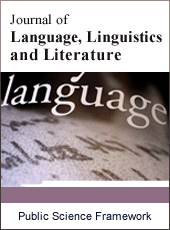Journal of Language, Linguistics and Literature
Articles Information
Journal of Language, Linguistics and Literature, Vol.1, No.6, Dec. 2015, Pub. Date: Oct. 19, 2015
Factors Enhancing Language Use in a Bilingual Turkmen Community in Baghdad
Pages: 175-181 Views: 3334 Downloads: 1160
[01]
Bader S. Dweik, Department of English, Faculty of Arts and Sciences, Middle East University, Amman, Jordan.
[02]
Sara N. Al-Rahal, Department of English, Faculty of Arts and Sciences, Middle East University, Amman, Jordan.
This study aimed at investigating the factors that enhance language use among the Turkmen of Baghdad. The study attempted to highlight the factors that led them to use their ethnic language and Arabic which is the official language of Iraq in different domains. The researchers selected a one-hundred-participant sample from the Turkmen of Baghdad covering different age, gender and educational background. The instrument of the study was open-ended interviews. Results showed that the Turkmen of Baghdad maintained their ethnic language and used it in different domains of language use. The results also revealed that social, cultural and political factors played a significant role in using their ethnic language in Baghdad. Arabic was used as a daily language of communication in all formal channels related to the government whether it is in education, i.e. schools, universities, in media or in official situations.
Language Use, Factors, Turkmen, Baghdad, Bilingualism
[01]
Abdelkhaliq, E. (2014). Factors influencing language and cultural maintenance among the Turkmen of Jordan: A sociolinguistic study. (Unpublished MA thesis). Middle East University: Jordan.
[02]
Al-Hassany, A. (2013). Al-Iraq Qadeiman wa hadithan. Lebanon: Dar Al-Rafidayn.
[03]
A-hurmuzzi, A. (2003). Turkmens and the Arab world. Iraq: Waqf Kerkuk company.
[04]
Al-Refa'i, T. (2013). The language situation among the Assyrians of Jordan: A sociolinguistic study. (Unpublished M.A thesis), MEU, Amman: Jordan.
[05]
Clyne, M. (1982). Multilingual Australia. Melbourne: River Seine.
[06]
Demirci, F. (1991). Irak turklerinin du¨nu¨-bugu¨nu¨ (The past and the present of the Iraqi Turks). Ankara: The Publishing House of the Institute of Turkish History.
[07]
Dweik, B. and Al-Obaidi, T. (2014). Syriac Language Maintenance among the Assyrians of Iraq. Journal of Sociology and Social Work. 2 (1), 269-282.
[08]
Dweik, B. and Nofal, M. (2013). Language maintenance among the Indians of Yemen: A sociolinguistic study. The international Journal of Arabic/English Studies. 14 (1), 89-112.
[09]
Ferguson, C., Heath, S., & Hwang, D.(1981). Language in USA. New York: Cambridge University Press.
[10]
Fillmore, L. W. (2000). Loss of family languages: Should educators be concerned?. Theory into Practice, 39(4), 203-210.
[11]
Fishman, J. A. (1964). Language maintenance and language shift as a field of Inquiry. Linguistics, 2 (9), 32 – 70.
[12]
Fishman, J. A. (1989). Language and ethnicity in minority sociolinguistic perspective. England: Multilingual Matters LTD.
[13]
Hoffman, J. & Cais, J. (1984). Children's attitudes to language maintenance and shift. lnternational Journal of the Sociology of Language, (50),147-153.
[14]
Matras, Y. (2009). Language contact. Cambridge: Cambridge University Press.
[15]
Menon, R. and Wimbush, S.A. (2007). The US and Turkey: End of alliance? Survival, 49 (2), 129-144.
[16]
Weinreich, U. (1974). Languages in contact: Findings and problems. Mouton and Company: The Hague Press.

ISSN Print: 2381-7054
ISSN Online: 2381-7062
Current Issue:
Vol. 6, Issue 1, March Submit a Manuscript Join Editorial Board Join Reviewer Team
ISSN Online: 2381-7062
Current Issue:
Vol. 6, Issue 1, March Submit a Manuscript Join Editorial Board Join Reviewer Team
| About This Journal |
| All Issues |
| Open Access |
| Indexing |
| Payment Information |
| Author Guidelines |
| Review Process |
| Publication Ethics |
| Editorial Board |
| Peer Reviewers |


